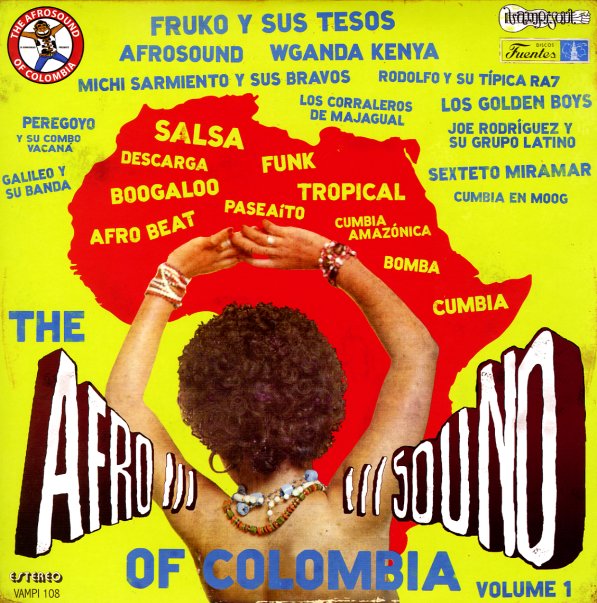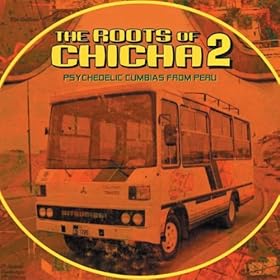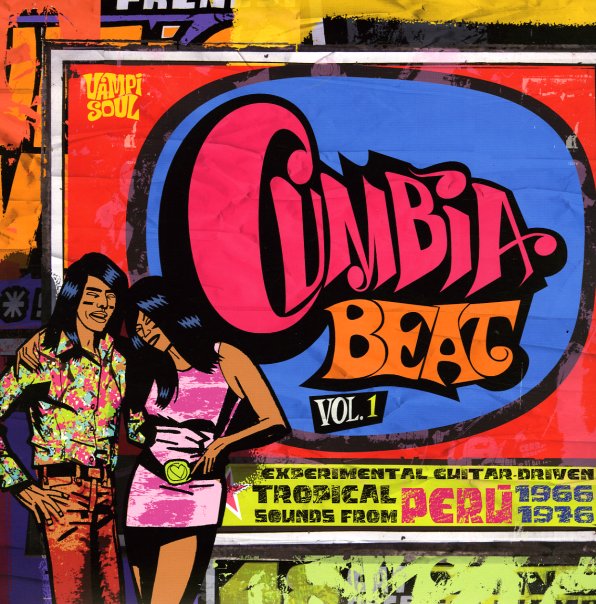



Are we in the midst of a cumbia renaissance? No doubt, folks who’ve been up on this style for years will scoff at the idea that cumbia is suddenly “hot” when it was never “cold” to begin with but at least from my (limited) vantage point, it certainly seems as if there’s been a recent surge in cumbia-related anthologies and compilations being pitched to the same crowds who previously were getting upped on everything from Ethiopian jazz to Panamanian boogaloo.
Yes, cumbia has gone hip(ster) but hey, I’m just as much part of that wave as anyone else and frankly, I’m all for cumbia getting shine no matter what the circumstances.
My first exposure to the magic of cumbia came during one of our many Boogaloo! nights at the Short Stop; it was probably Rani D of Soul in the Park guest-DJing and as he threw in a few cumbia joints in the mix, you could see the dancers viscerally react to it; it’s like you threw some “get hype” switch in their heads.
There’s something marvelously simple about a cumbia rhythm and notice I said “simple” and not “simplistic.” The most distinctive attribute about a cumbia song – no matter old or new or what country it emerges from – is that telltale “two step” rhythm. Listen to a cumbia beat and imagine your head was a metronome and sure enough, you can dip-dip, dip-dip, dip-dip to that rhythm like it was the most natural thing in the world. That plays a huge role in making cumbia such an irresistible force on the dance floor.
It also, I imagine, explains why it’s been such a portable rhythm, emerging out of the coastal regions of Colombia and then traveling across South, Central and North America. That two-step rhythm meshes well with many other music styles, most notably polka, especially once Colombian musicians began to incorporate the accordion into their repertoire.
If you’re a cumbia noob (like me), then you might as well begin with the new Beginner’s Guide to Cumbia, put together by our buddy DJ Bongohead. It’s a 3-CD comp that serves as a decent primer to cumbia styles of the past, present and future. I do wish the liner notes had been more comprehensive – what’s there certainly offers some important historical sweep but compared to the dozens of pages found for the other comps I discuss here, I would have thought a Beginner’s Guide would be more in-depth. What’s notable is that one of other comps I’m writing about, The Afrosound of Colombia is also curated by Bongohead and that’s got a frickin’ encyclopedia of knowledge in there so I’m left to assume that The Beginner’s Guide to Cumbia simply suffered from a limited production budget (the 3-CD comp only costs $14; do the math). In any case, here’s a sampling of various tunes:
Andrés Landero Y Su Conjunto: La Pava Congona
La Sonora Dinamita: Gaita Frenética
Banda Cuxpala: Mar Y Sol
Very Be Careful: Ojitos
Andrés Landero Y Su Conjunto: La Pava Congona (Senor Sabor Remix)
Chancha Via Circuito Ft. Kumbha: Kethu Bosques VÃa Temperley
All from The Beginner’s Guide to Cumbia (Nascente, 2010)
The Landero, to me, really captures what I’ve come to think of as classic cumbia. Truth be told, it’s not like cumbia has to have accordion in it and I know quite a few people who can’t stand the sound of the instrument in cumbia tunes but I’m with it. That wheezing sound somehow works in the rhythm and the Landero has a nice, slow burnin’ bump to it. I do love the particular percussive elements that go into Colombian cumbia and I picked the La Sonora Dinamita track to highlight a few of those layers.
From the “Contemporary” disc, I went with Mexico’s Banda Cuxpala to showcase some of the versatility of the cumbia rhythm, especially how it’s worked its way into any number of Mexican styles. And since Bongohead showed love to L.A.’s own Very Be Careful, I had do the same by including one of their tunes. I still need to see these guys perform live (I’m wack for taking so long to do so).
From the “Future” disc, I went with the Senor Sabor remix of that Landero cut I played earlier, so you can get an idea of how contemporary remixers can work with a classic cumbia and bring it into their own aesthetic. And the Chancha Via Circuito? I just like how the thing sounds – super-sparse and open but once that core cumbia beat drops, try to stop your head from bobbing along.
For all the myriad styles of cumbia, it’s still the Colombian versions that I know best, not the least of which has been from all the attention lavished on the legends of the ’60s and ’70s, especially those who recorded for Discos Fuentes. Soundway was one of the first to blow up Fuentes to the larger non-Latin world and this year, Vampi Soul has followed with their own Fuentes’ inspired comp, The Afrosound of Colombia.
I’m pretty certain Bongohead managed to avoid any crossover between the songs he chose and what appeared on Colombia!, a testament to how incredibly vast and awesome the Fuentes catalog is. True to its title, the anthology tends to focus on the more “Afro-influenced” recordings but it’s a deliberately hazy label since “Afro-influenced” could really apply to any number of particular styles and on some songs, such as Sexteto Miramar’s lively “Sabor,” it mostly just sounds like a kick ass salsa dura cut to me. Regardless, this anthology packs some of my all-time Fuentes titles – I mean, had I been asked to curate this, I probably would have chosen at least 30-40% of the same songs. And as I learned, many of those songs can be traced back to the legendary Fruko, who seemingly had his hands in everything at Fuentes. Not only was he a prolific artist in his own right, but I didn’t realize he was also arranging for two of my other favorite Fuentes artists – Afrosound and Wganda Kenya. Over 3/5ths of this album was touched by his genius and it spanned an impressive range of musical styles that drew from across the diverse South American landscape.
Here’s just a few selections:
Afrosound: La Sampuesana
Los Corraleros De Majagual: Los Sanabales
Wganda Kenya: El Abanico
All from Afrosound of Colombia (Vampi Soul, 2010)
As I learned from the extensive liners, Afrosound was Fruko and Fuentes’ response to the burgeoning cumbia amazonica sound (what eventually became known as chicha in Peru and something I write about below) and in terms of sheer diversity and pure funk, it’s hard to imagine a more enjoyable Fuentes group out there. This whole comp could have just been Afrosound songs and it would have rocked. In any case, what I always liked about “La Sampuesena” is how it starts with that Brazilian-flavored keyboard melody and then immediately drops into a shuffling cumbia rhythm, complete with those muscular guitars. The Peruvian sabor can be heard on that high, almost whiny synthesizer that snakes in as well as the more psychedelic guitar touches.
Los Corraleros De Majagual bring us a vallenta-style cumbia which sounds deceptively simple but I love how clean everything is here – the accordion, the clopping beat, the multi-voice harmony. There’s such a pure simplicity to all these elements working in unison and despite lacking a bass or more elaborate percussion, I dare you not to dance to this.
I know the Wganda Kenya song isn’t a cumbia (and this is supposed to be a cumbia-themed post) but I couldn’t NOT highlight one of my favorite songs by this group – another gem in the Fuentes stable – since it’s clearly the group covering “Wicky Wacky” by the Fatback Band. That is CRAZY (awesome). This was one song I sort of kept snuck away from the blog, but now that Bongohead let the cat out the bag, no reason not to share it.
As noted, the transplantation of cumbia from Colombia to Peru produced a new hybrid in its wake. It went by many names though, since the 1970s, the term chicha (named after a corn-based, alcoholic drink) has stuck to a music style that incorporates all kinds of different elements, most notably electric guitar (often in a surf style) and cumbia rhythms. Personally, I find chicha to be more a subtle, listening music than something that’s going to blow up the dance; there’s something silkier to its feel even though a strong rhythmic foundation is ever present. (The liners, by Olivier Conan, also point out the fascinating class politics around chicha – a term that seems assiduously avoided by “respectable” Peruvians given its association with a decidedly lower class). Anyways, here’s a pair of tunes:
Los Destellos: Constelación
Los Ilusionistas: Colegiala
From The Roots of Chicha 2 (Barbés, 2010)
Los Destellos are credited as chicha’s originators and from experience, it’s hard to go wrong with any of their albums from the ’70s. “Constelación” is thick with its layers of cross-pollination. So obviously psychedelic on one hand but that cumbia rhythm bumping off underneath is just as omnipresent.
I selected Los Ilusionistas’ “Colegiala” because much of the chicha I’m familiar with is instrumental but I thought it’d be worth listening to what it sounds like to have a vocalist on top, in this case, Carlos Ramirez, who does a nice job of bringing his youthful voice atop the distinctive plucking of band’s guitarists.
I’d also be remiss in not revisiting an artist I mentioned the other day, Ranil y su Conjunto. Ranil has a song on The Roots of Chicha (not found on this other album) and he was an important figure in the scene partially because, unlike many of the other, Lima-based artists, Ranil came from the heart of the Amazon: Belen. The more I’ve been listening to Mass Tropicas’ anthology of Ranil’s work, the more I’m drawn to the sophistication of his arrangements. This is to take nothing away from his peers but much as I like Los Destellos and Los Diablos Rojo, there’s some ineffable quality to Ranil’s songs that I find even more mesmerizing, especially on this song:
Ranil and His Tropical Band: Cumbia Sin Nombre
From Ranil’s Jungle Party (Mass Tropicas, 2010)
It’s fast for a cumbia but everything on this totally clicks in place; it’s the most dance-able track on the album and there’s such a vibrant yet soft pulse that moves the tune along.
Just in case you can’t get enough Peruvian cumbia, there’s also this comp which I briefly spotlighted the other month for my “Side Dishes” segment on KPFK’s Melting Pot show (which I’ll be guest-hosting this Sunday): Cumbia Beat Vol. 1 (another Vampi Soul project).
Between this and The Roots of Chicha, you have a ton of information to sift through (though I did wish both comps had done song-by-song liners in addition to general histories – yeah, I’m picky like that, deal with it) and impressively, though both heavily highlight Los Destellos (impossible to avoid) and another seminal band, Manzanita y su Conjunto, there’s actually little overlap between the two. To wit:
Los Diablos Rojos:Â Malambo
Los Mirlos:Â Lamento En La Selva
From Cumbia Beat (Vampi Soul, 2010)
Los Dialbos Rojos were one of the first chicha groups I discovered – at the very least, they have some great cover art and a real consistent sound that’s in the same vein as Los Destellos. “Malambo” is a slick number, sounding like its namesake as the meeting point between mambo and cumbia; lot of charm on this one. Los Mirlos’ “Lamento En La Selva” comes off with a smokier feel, and would be almost noir-ish if not for the strong percussive elements that are so prominent in the mix.
And now we come to the capstone:
Quantic y Conjunto: Dre En Cumbia (2010)
So…a few weeks back, I wrote Will Holland to tell him how much I enjoyed listening to “Cumbia De Dilla” which was in that Jeremy Sole mix. During out exchange, he asked if I had any other suggestions for hip-hop songs to cumbia-fy and what came to mind was “Nothin’ But a G-Thing.” Something about the song mentally “worked” in my head when I threw a cumbia beat behind it (note: you absolutely can’t do this with just any rap song. Try “Award Tour.” Wouldn’t work. But “Bucktown”? Hell yeah).
In any case, Will hit me with an email this morning with “Dre En Cumbia” attached and instantly made my whole week. I heard he played this at his Do-Over set from this past weekend as well (wish I could have been there but didn’t realize he’d be spinning. Bummer).
Seriously, MORE HIP-HOP CUMBIAS PLEASE. I really dig the subtlety of what’s he doing here, especially in working in the melody of “G-Thing” plus a little “Next Episode” at the end but he’s neither hitting you in the head with it nor being ironic with it like fey singer-songwriters who seem to get off on covering gangsta rap on acoustic guitar.



Great post, O. We are certainly in the midst of a resurgence and the momentum seems to have really swelled in the last couple of years. Are you familiar with the “digital cumbia” of Zizek crew from Buenos Aires? Not to pimp my own site, but I interviewed a couple of those guys for a short podcast at http://www.thecornermusic.com/2010/08/cornercast-zizeks-digital.html
Nice post – you might want to check out Trio Electromondo from Sweden (as a bonus the video is great)
Wow, amazing post, thank you!
wow, i never thought you’d be covering cumbia O…this has been a best kept secret for a loooooong time amongst the latinos. dopest post yet.
There is resurgence of Cumbia also within Colombia. This music has in the past been typically dismisssed as Christmas music but there’s people like “Frente Cumbiero” doing great hip/trip hop Cumbia stuff. I believe they’re about to release a 45 with Mad Professor.
If you’re interested here’s their Mix called “Rompetrinche”:
http://colmenadehumo.blogspot.com/2010/05/frente-cumbiero-rompetrinche_30.html
Also recommended is the work of Sonido Martines.
you should also check out l.a’s Very Be Careful. They’ve been doing beautiful Cumbia for about 13 years.
Great post! Thanks, OW.
One of my favorite songs discovered this year is “La Cumbia del Mole” by Lila Downs, from the album La Cantina (2006).
I recently allowed the psychedelic sounds of chicha and hypnotizing rhythms of cumbia enter my life. Being Ecuadorian, I’ve always heard this music played at parties and on the streets of Quito but never really went deep into the genre, except for Colombian cumbia. I feel like i’m doing humanity a disservice if I don’t spread the word about this now! I have NEVER followed a blog, this will be my first. FANTASTIC POST!!!
cumbia? sounds more like crap